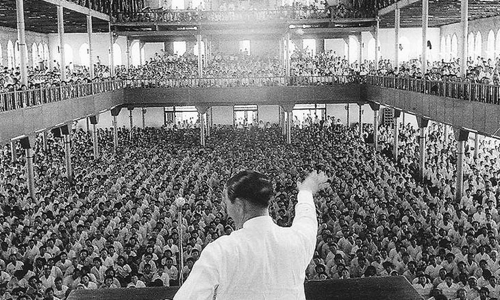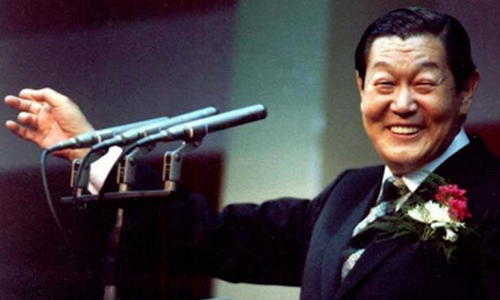In a lecture given to his followers on the summit of Mount San San, Park Tae-son said he saw water and fire falling from heaven.
The sermon was given by Park Tae-son in April 1955 in Seoul, South Korea, during a large-scale rally attended by a number of religious leaders. Park, born in 1915 in a place in North Korea today, from a young age joined the Presbyterian Church, a branch of Protestantism, according to James Grayson, a professor of Korean studies at Sheffield University, England. .

Park Tae-son preached to his followers in 1957 Photo: The Weekly.
Believing that he had purified his soul and given "great power," Park walked down the podium in the middle of the rally and rubbed the head of a lame man for 30 years. It is said that Park's actions healed the man, marking a turning point not only for Park, but also for new Christian movements in Korea.
Park then established his own movement called the Olive Tree Church. Before his sermon on Mount San San, South Korea also appeared mysterious forms of evangelism, combining Bible teaching and some elements of Korean folk religion. However, no movement has reached the level of influence and power of Park's Olive Tree Church.
The olive tree quickly became one of the two influential Christian origin movements in Korea in the 1950s and 1960s. The other movement was the Spiritual Association for World Christian Unity, or more popularly known as the Unified Church, founded by Moon Sun-myung. Today, the church is famous worldwide for its mass wedding ceremony, with thousands of couples getting married at the same time.
Cults and their unique rituals especially attracted South Koreans in the late 1950s and early 1960s. This was a period of turbulent society, when the agricultural economy was poor. devastated by the devastating civil war.
South Korea has become one of the most modern and developed economies in the world in just one generation. This leap, often called the "Miracle on the Han River", was driven by the military government of the late President Park Chung-hee, with an emphasis on investment in industry and infrastructure.
From 1964 to 1995, gross national income (GNI) per capita in Korea increased from US $ 100 to US $ 11,432. However, economic performance is not equally divided among all. Those who have not benefited from the Park administration's efforts "feel frustrated by the country's policies after the Korean War," said David Kim, a professor at the Australian National University.
Tark Ji-il, a professor at Busan Elder Church University, Korea, added that many Koreans were also pessimistic about the future due to the Japanese colonial period, World War II and the Korean War. Fairy. Lacking faith in the government, they turned to religious leaders who promised to save their souls and bring peace to them.
In the process of industrialization, many Korean Christians who feel left behind by society have joined Park Tae-son's Olive Tree Church, attracted by the idea of establishing a modern Sanctuary. They want to recover mentally, mentally and physically through Park's healing of faith. Professor Kim said even "ordinary people", with little or no knowledge of Park's teachings, participated.
Everyone who was caught up in the teachings of the religious leader had a wide smile and a black roof. Many believers have even moved to a self-sufficient town built by the Olive Tree Church near Seoul, including schools, factories and apartment buildings.

Park Tae-son Olive Tree Church founder Photo: World Religious and Security.
Massimo Introvigne, a religious scholar in Italy, said that at its peak, the Olive Tree Church had 2 million members. People have been joining in spite of a growing row of controversy surrounding Park, including his brief imprisonment for embezzlement.
However, the influence of the church did not last long. Park eventually angered his followers by declaring Jesus an impostor, and he was the true Savior. A series of members left the church in the mid-1960s. When Park died in 1990, the number of believers plummeted.
Many white churches hung red crosses across rural Korea, which once belonged to the Olive Tree Church, which was gradually abandoned and often used as a village shed, instead of a place of worship, Professor Grayson said. good.
One of the people leaving the church was a Korean War veteran in his 30s, who spent 10 years listening to Park preach. He is Lee Man-hee, the founder of Tan Thien Dia, a sect that is attracting attention because it is involved in more than half of nCoV infections in South Korea.
After leaving the Olive Tree Church, Lee and some of the founders of the Tabernacle religion in the 1970s. However, Lee soon left the group after accusing co-founders of fraud, Introvigne scholar said, based on two interviews with Lee. On March 14, 1984, Lee finally established Tan Thien Dia, his own religious organization.
Experts say most sects of Christian origin in Korea were established in a similar way to the New Heavenly Earth. These groups diverged from the Olive Tree movement or the Unified Church, which still relied heavily on the symbols of the Book of Revelation, led by individuals who claimed to possess some sacred power. Some cardinals claim to be prophets, or say that they alone are capable of interpreting the Bible.
Professor Grayson said mainstream Christians in Korea considered religious groups that doubted Jesus' power to be heretical, including the New Heavenly Yard. This sect is also particularly annoying because it is said to attract members from other churches.
South Korea currently has hundreds of religious minorities similar to New Heavenly Earth, according to Professor Tark. However, experts consider this to be a consequence of Korea's special political, socio-economic history, not representative of Christianity or religion in the country as a whole.



 IreneMaciulis
IreneMaciulis







